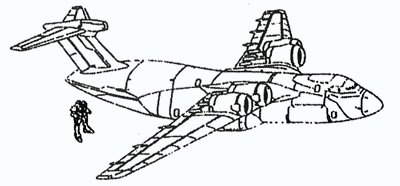|
C-181 Starlifter IV
Unit
type: strategic airlifter/mobile suit transport The C-181 can literally be described as a "flying fossil" which has survived in various permutations for nearly two centuries, with the first examples flying in the early years of mobile suit development under the U.N.T. Army in the UC 80s. In spite of this veritable antiquity, the Starlifter was in main combat use with the Earth Sphere Alliance military right up until the formation of the Earth Union in UC 219, and can still be encountered in use for transporting materials and weapons in rear-line service. In addition to the Earth Union, the venerable C-181 is flown by a number of other operators throughout the world who are eager to take advantage of the aircraft's ubiquity and ease of finding spare parts. Compared to a number of other aerial vessels that can be encountered today, the C-181 is an extremely conservative and "old-fashioned" design, and is purely intended to act as a transport. Up to six standard-size mobile suits can be carried in a squatting position in the cavernous main hold, and are loaded or unloaded via a hydraulically-activated ramp below the tail. Embarked mobile suits can also be deployed in flight, allowing the C-181 to act as a carrier vessel as well - airborne mobile suits may simply begin flying once clearing the plane's jetwash, while land-based units are usually fitted with a parachute pack in order to land safely. The Starlifter is capable of high subsonic speeds and a great maximum cruising altitude, but lacks any kind of appreciable maneuverability. Combined with a thin titanium/composite fuselage and a lack of any defensive weapons, the aircraft is a total noncombatant. While enough space is provided for the aircraft to carry some extra ammunition and weapons for its mobile suits it lacks the ability to perform signfiicant in-flight service or repairs either. The examples still in service with the Earth Union were unable to be outfitted with recharging systems for GN drives, which has further limited their use to purely logistical roles. Nevertheless, in spite of the various drawbacks of the aircraft's age, its simple and reliable ability to field mobile suits along with the ability to land on relatively short runways in spite of its size will likely ensure its continued usage into the next century as well. |



